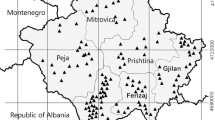Abstract
In this paper, we report the inter-laboratory validation (ILV) of a recently developed indirect competitive multiplex dipstick (Bee4sensor®) which is capable of the simultaneous detection of residues of some of the most frequently detected antibiotic residues in honey: sulfonamides, tylosin, fluoroquinolones and chloramphenicol. The multi-sensor dipstick can be interpreted via visual observation or by an instrumental measurement of four test lines. Statistical analysis of the ILV data demonstrated that the multi-sensor can reliably detect the presence of sulfathiazole at 25 μg kg−1 and tylosin at 10 μg kg−1, which fully meet the ‘recommended concentrations’ of the EU. Ciprofloxacin and chloramphenicol can be detected at 25 and 5 μg kg−1 in honey, respectively. Whilst the concentration for chloramphenicol is above the EU minimum required performance limit of 0.3 μg kg−1, this part of the multiplex test may still be of use to both the industry and enforcement authorities, to provide an early warning of contaminated honey. The estimated false-negative and false-positive rates for this easy-to-use and robust assay were less than 5 %.





Similar content being viewed by others
References
Codex (2010) Discussion paper on veterinary drugs in honey production ftp://ftp.fao.org/codex/meetings/CCRVDF/ccrvdf19/rv19_10e.pdf. Accessed 3 Jan 2013
US Food and Drug Administration database. http://www.accessdata.fda.gov/scripts/animaldrugsatfda/details.cfm?dn=013-076. Accessed 3 Jan 2013
RASFF portal. https://webgate.ec.europa.eu/rasff-window/portal/#. Accessed 3 Jan 2013
European Commission (2003) Commission Decision 2003/181/EC of 13 March 2003 amending Decision 2002/657/EC as regards the setting of minimum required performance limits (MRPLs) for certain residues in food of animal origin. L71. 17–18
CRL guidance paper (2007) http://www.rivm.nl/bibliotheek/digitaaldepot/crlguidance2007.pdf. Accessed 3 Jan 2013
Community reference laboratories (2010). Guidelines for the validation of screening methods for residues of veterinary medicines (initial validation and transfer). http://ec.europa.eu/food/food/chemicalsafety/residues/Guideline_Validation_Screening_en.pdf. Accessed 3 Jan 2013
Reybroek W, Ooghe A, De Brabander H, Daeseleire E (2007) Validation of the tetrasensor honey test kit for the screening of tetracyclines in honey. J Agric Food Chem 55:8359–8366
Gaudin V, Hedou C, Verdon E (2013) Validation of two ELISA kits for the screening of tylosin and streptomycin in honey according to the European Decision 2002/657/EC. Food Addit Contam Part A Chem Anal Control Expo Risk Assess 30(1):93–109
Conffidence (2010) Conffidence project website. http://www.conffidence.eu/img/enewsletter/enews_WP2b_antibiotics_newsletter_Nov_2010.pdf. Accessed 3 Jan 2013
Unisensor (2012) Bee4sensor® webpage. http://www.unisensor.be/en/catalog/antibiotics-28/bee4sensor-45.php. Accessed 3 Jan 2013
European Commission (2002) Commission decision of 12 August 2002 implementing Council Directive 96/23/EC concerning the performance of analytical methods and the interpretation of results. L221. 8–36
Brown LD, Cail TT, DasGupta A (2001) Interval estimation for a binomial proportion. Stat Sci 16(2):101–133
Mee RW (1984) β-expectation and β-content tolerance limits for balanced one-way ANOVA random model. Technometrics 26(3):251–253
Feinberg MJ (2007) Validation of analytical methods based on accuracy profiles. Chromatogr A 1158(1–2):174–183
Adams S, Heinrich K, Fussell R, Wilkins S, Thompson H, Ashwin H, Sharman M (2008) Study of the distribution and depletion of chloramphenicol residues in bee products extracted from treated honeybee (Apis mellifera L.) colonies. Apidologie 39:537–546
Acknowledgments
The Conffidence project is funded by the European Commission, call identifier FP7-KBBE-2007-1, grant agreement number 211326. The authors wish to thank the surveillance, LC-MS/MS teams and Michael Knaggs at Fera for analysing the test materials for residues of antibiotics and homogeneity. The authors thank the company Unisensor s.a. for supplying the test kits, instrumentation and their continuous support. The authors like to acknowledge the following laboratories for participating in this study: Fera (UK), CER (Belgium), Rikilt (The Netherlands), ILVO (The Netherlands), ANSES (France), Michaud (France) and one other.
Author information
Authors and Affiliations
Corresponding author
Rights and permissions
About this article
Cite this article
Heinrich, K., Macarthur, R., von Holst, C. et al. An inter-laboratory validation of a multiplex dipstick assay for four classes of antibiotics in honey. Anal Bioanal Chem 405, 7875–7884 (2013). https://doi.org/10.1007/s00216-013-7070-3
Received:
Revised:
Accepted:
Published:
Issue Date:
DOI: https://doi.org/10.1007/s00216-013-7070-3




